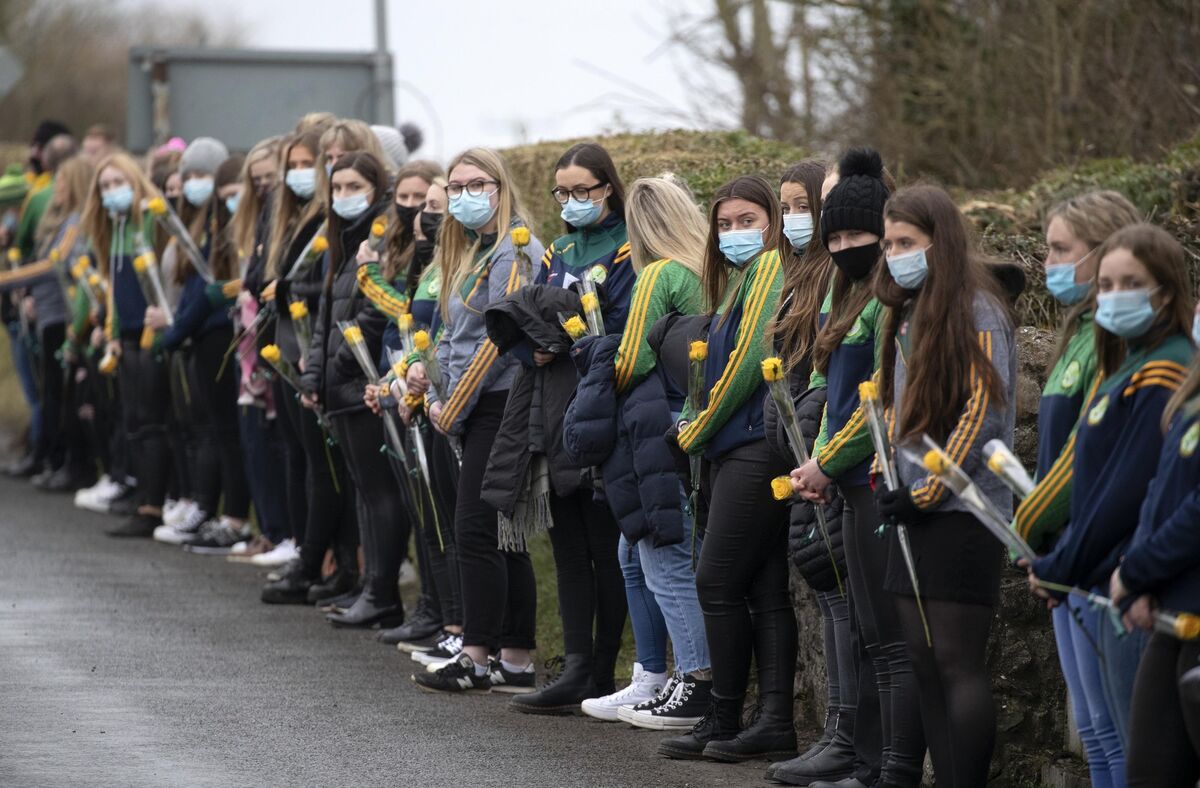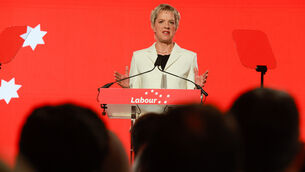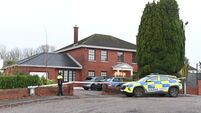Alison O’Connor: Sidelining women in GAA power structure an own goal in misogyny

Members of Kilcormac Killoughey GAA club form a guard of honour at the funeral of Ashling Murphy last month. Picture: Damien Eagers/PA
An interesting article posted on the GAA website this week looks at how the association, a bedrock of Irish society with its 700,000 members, is “an entity founded by men and moulded within a patriarchal system”.
Written by the GAA community and health manager, Colin Regan, it surprises on a few levels.
Firstly that it was included in the GAA club newsletter for February, but also singled out on the website as worthy of reading. It is a comfort to think that a man such as he is working from within the GAA for more equality.
We need more like him. As well as his article, this column will look specifically at the gender breakdown of the GAA’s 29 national committees — where the real power lies.
Mr Regan explains he wrote the article in the wake of the killing of Kilcormac Killoughey camogie player Ashling Murphy.
The association, he added, has recognised this and is on a journey towards addressing the imbalances, biases, and behaviours, that manifest in such a system.
“These can be experienced by our female members as a lack of representation or perspective at leadership levels, sexism, stereotyping, condescension, and a lack of respect.”

In the aftermath of the fatal assault of Ashling, he asked a key question, given the pivotal role of the GAA and its place in every parish: What could the association do to help move Irish society towards greater inclusivity and equality?
“As men, we need to take a good look at ourselves, our attitudes, biases, and behaviours. We also need to look inwardly as an association.
There are men in the GAA who recognise that a truly healthy club and association is one where male and female qualities complement each other and become more than the sum of their parts.
“We need to engage these men and urge them to be the agents for positive change in every aspect of their lives,” Mr Regan writes. “Including when they are on a WhatsApp group and inappropriate or degrading content or comments are made about women. Or when they are in a pub or club and a drunken friend or team-mate gropes a girl. Or when they see any woman being singled out or in need of an ally.”
Right on target, he points out how some people may ask how this is linked to Ashling’s death, but points out how gendered violence does not happen in a vacuum: “It is part of a continuum. It often begins with disrespect, a lack of empathy ... We need to place our female games on a level playing field.”
Bravo Colin.
But before we get too carried away, let us look at those facts and figures. According to information supplied by the GAA, there are 29 national committees. A spokesman pointed out that not all of these are appointed by the GAA president — some are mandated.
The figures are even more stark when it comes to the committee chairs, which are overwhelmingly male at 88%.
Beginning with the powerful management committee — effectively the board of the GAA — it has 16 men and four women. One of those women is from the Ladies Gaelic Football Association and the other from the Camogie Association. It is not known if they have voting rights. A third woman is the committee secretary. A fourth is a senior academic.
Another powerful committee, the central competitions control, has just one woman out of 10, as does the central hearings committee.
Another big hitter, the central appeals committee, has two out of 10. There is no woman on the referees appointments committee, as is the case with the development competitions control committee. Quite remarkably, given the gender balance of the teaching profession, there is not one woman on the All Ireland post-primary schools council.
The committee that dictates rule changes has two women out of eight. The financial management committee has two women out of 12, and in that instance, one of them is the committee secretary.
Sport Ireland points out the Government’s target for State boards is a minimum of 40% of each gender by the end of 2023. Its latest snapshot of female representations means we can say with confidence at this stage the GAA will dismally fail to reach this target. Its current figure is 20%. Perhaps GAA president Larry McCarthy will take solace from the fact the FAI is only 17%, and the IRFU a pathetic 13%.
It is all tokenistic at best. Unsurprisingly only two GAA committees have more women than men. The one which oversees the organisation of Scór na nÓg, with six women and five men, and the health and wellbeing committee with seven women and three men. There is an equal number of men and women on the national child safeguarding committee. These committees clearly do really important work, but do not have the power of those mentioned earlier.

Given how unusual it was, we’re all inclined to remember the first woman to hold the position of Cork County Board chairwoman, Tracey Kennedy. In December 2020, as she was leaving the role, she said the “GAA, as an association, leaves a lot to be desired when it comes to gender balance”.
Ms Kennedy spoke about the men’s and women’s games needing to be run by one national body. I wholeheartedly agree. The existence of the LGFA and the Camogie Association allow the men in the GAA too much wriggle room on their obligations.
It is extraordinary, for instance, to think that a few years ago the Tyrone ladies football team had to pay €13,000 for training and matches to the Tyrone County Board for a facility built for Tyrone GAA teams.
Asked about its policy on gender balance on all these committees the GAA said it, the LGFA, and Camogie Association established a joint diversity and inclusion working group, with equal representation. Its remit is to develop a diversity and inclusion framework for the Gaelic Games Associations. The first pillar on positive participation of the LGBT+ community has been drafted and is being discussed. Four other pillars, including one on “promoting equal gender participation in our overall structures” are currently being developed.
The GAA deserves kudos for publishing that article. The next step is to publicly acknowledge the role of women remains marginal in decision-making in the association.
They don’t like to hear it, but the men who rule the roost here need to realise that maintaining such structures, continuing to sideline women and the blatant withholding of power, adds up to an own goal of misogyny.












